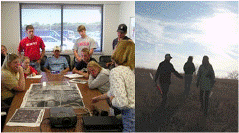Environmental and Sustainability Studies Program

Department of Environmental Studies: Undergraduate Student Theses
Date of this Version
Winter 12-2011
Document Type
Thesis
Abstract
To most Americans the Great Plains region of North America is mysterious place. There are disagreements when defining its limits, and some people just refer to it as the Midwest. The Great Plains has been a place under an ocean, a place under glaciers, and a place on fire. It was once dubbed “the Great American Desert,” but is now known for its agricultural viability. The Great Plains sparks imagination because it is so massive and was one of the final frontiers for Euro-American settlement. The Great Plains is seen as a rural place but the majority of the region’s population lives in urbanized areas. Data from the Census website (census.gov) show that American Great Plains states have urban population majorities, including North Dakota (56% urban), South Dakota (52% urban), Nebraska (70% urban), and Kansas (71% urban). With such a seemingly infinite amount of space and low population density in the region, it is easy for city planners and developers to design cities and infrastructure in a way that can be described as urban or suburban sprawl, a low-density and auto-dependent development method that takes up farmland, rural land, and fragments wildlife habitats.
This paper will look at the urban settlement patterns of the Great Plains in a way that shows both positive and negative aspects of urbanization. First, the epochs of settlement in the American West after the year 1800 will be discussed. This is followed by an in-depth discussion about the historical urbanization of the Great Plains, defining the urban structure of the region, classic city archetypes, different eras of migration, and other reasons these cities came into existence. Later, the city of Lincoln, Nebraska will be used in the case study section as an example of a Great Plains city. The case study will compare the Lincoln of 1885 to the Lincoln of 2010, showing the change in the city’s limit over the past 125 years.
The study will also define the urban growth rate, population change, and how much land has been converted from farmland or rural land to the urbanized zone we call Lincoln. By using Lincoln as an example, the paper will analyze methods for development that help slow city growth in the Great Plains by using economic, political, and public service incentives like impact fees, zoning laws, and utility allotment for new developments. After identifying the positive and negative aspects of Lincoln’s growth management, the findings will be compared to other cities in the region to assess what other towns and cities do to regulate urban sprawl and development from taking over rural lands, agricultural lands, and wild-life habitats. The best way to analyze urban development in the region is to start from the beginning, with the arrival of Euro-American settlers.
Included in
Cultural Resource Management and Policy Analysis Commons, Environmental Design Commons, Environmental Sciences Commons, Growth and Development Commons, Human Geography Commons, Other Public Affairs, Public Policy and Public Administration Commons, Urban, Community and Regional Planning Commons, Urban Studies and Planning Commons

